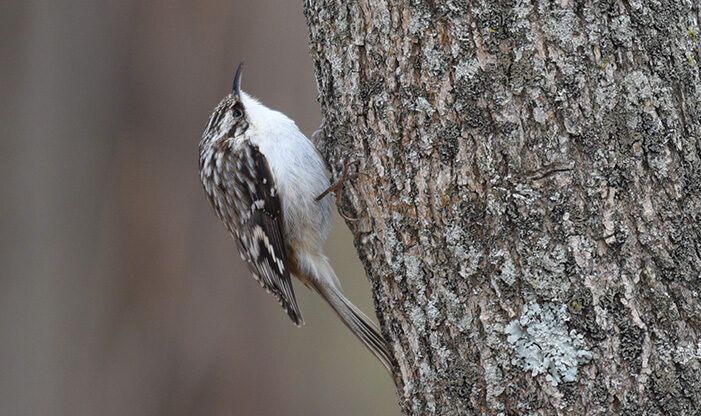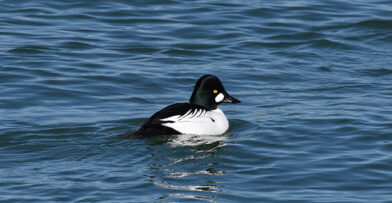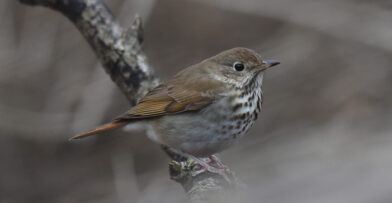Our Bird Profile series highlights a species that is migrating through, breeding, or is a year-round resident of Wisconsin that can be found at Schlitz Audubon or in your backyard.
Name
Brown Creeper, Certhia americana
Basic Description & Appearance
Named for their food foraging style, the tiny Brown Creeper measures, on average for both sexes, 11.5-13.5 cm in length, and weighs about 7-10 grams. The adults are brown on top with heavy, dull white streaking on their head, wings, shoulders, and back, with the underparts a whitewashed color mixed with cinnamon hues. Their plumage looks similar throughout the year. The bird’s tail is long and stiff and is used to prop the body against a tree’s trunk. Males and females look alike, except for their bill size; the female’s bill is 1-2 mm shorter than the male’s bill, which can differentiate the bird’s sex. Brown Creepers are well camouflaged, making them difficult to spot if they aren’t moving.
Vocalization
The male Brown Creepers song is rich and high-pitched, with ‘tsee’ notes resembling those of a Golden-crowned Kinglet. The males sing during mating season on their breeding grounds, but usually not during migration. It’s difficult to hear the individual notes of their song because it is so delicate.
Their high, wavering call sounds like the tinkle of a chain dropping and is longer than many other birds. Both sexes call all year long, especially while foraging, while males call in courtship and other displays.
Habitat & Nesting
During breeding season, Brown Creepers prefer the large trees found in both coniferous, mixed, and deciduous forests, preferably undisturbed old-growth forests. While overwintering, they are found more often in deciduous forests, as well as urban and suburban areas. They use big, living trees for foraging, and mostly large, dead trees for nesting.
Birds of this species make their nests in unusual places. Most often found in between loose pieces of bark and the tree trunk of a dead or dying tree, they will occasionally nest in living trees with peeling bark. They have also been found within stacks of concrete blocks, behind loose roof shingles, in fence posts, and other places.
The Brown Creeper’s range is throughout North America, from Alaska and Canada south to northern Nicaragua. Usually considered a year-round resident through most of their range, the northern breeding populations will migrate south. Their non-breeding range is found in parts of southern Canada and the central and southeastern U.S. Fall migration for the midwestern states is mainly in September and October, while northward spring migration peaks in April and May.
Diet & Foraging
This little bird’s diet consists of mainly insects during the warmer months. Their signature foraging technique involves creeping up a tree trunk and inserting their slightly curved bill in the bark to probe for insects. They move upward in a spiral, never going down the trunk as a nuthatch does. When they reach the top, the birds will then flutter down to the forest floor and start spiraling up another tree to search for more food. In winter, Brown Creepers will eat suet, peanut butter, seeds, and corn.
When & Where to Find at Schlitz Audubon
This species is found in our forest habitats, seen creeping up large trees foraging for food, peaking in April and during fall migration.
Other Fun Facts
- Some Brown Creeper nests have two openings, one for entering and one for exiting.
- Brown Creepers burn an estimated 4–10 calories per day; the energy from eating one spider is enough to propel the bird 200 feet upward.
- They are sometimes used as indicator species to help gauge the effects of logging on wildlife.


